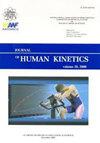W´BAL-INT 训练模型与临界功率测试的生理反应比较
IF 1.9
3区 医学
Q2 SPORT SCIENCES
引用次数: 0
摘要
本研究旨在比较 W prime(W´)平衡训练模型(W´BAL-INT)期间的急性生理反应与临界功率测试(CPTest)中的表现。此外,该研究还试图确定与严重和极端强度领域相关的神经肌肉和代谢疲劳程度。14 名公路自行车高手(13 名男性,1 名女性)完成了分级增量运动测试,以确定他们的最大摄氧量,并完成了 12、7 和 3 分钟的最大努力,以评估 CP 和 W´ (CPTest)。此外,他们还按照 W´BAL-INT 模型参加了重组间歇训练。测量了生理反应,包括摄氧量(V.O.2)、心率(HR)、血液乳酸(BLa¯)浓度和知觉反应(RPE),并与 CPTest 成绩数据进行了比较。W´BAL-INT 在 V̇O2mean(F = 0.76,p = 0.655)和绝对心率、相对心率和 HRCP(分别为 F = 0.70,p = 0.704;F = 1.11,p = 0.359;F = 1.70,p = 0.095)方面引起的稳态生理反应与 CPTest 相当。在训练课程的 3 分钟工作间歇期间,V.J.O2 保持稳定,与 CPTest 的 V.J.O2 峰值(54.2 ± 6.7 至 59.3 ± 4.9 ml-kg-1-min-1)相似。此外,4 分钟的休息间歇有助于恢复到中等疲劳水平(80%-100% W´ 平衡)。心率反应对间歇强度和累积时间很敏感。同时,BLa¯反应和RPE增加了W´BAL-INT期间的疲劳发展。W´BAL-INT 训练模式在平均氧动力学、CP 百分比和心率方面产生了一致的生理反应,与 CPT 测试中观察到的反应相似。然而,在峰值氧动力学和 W´ 能量平衡方面观察到了不同的生理反应。本文章由计算机程序翻译,如有差异,请以英文原文为准。
Comparison of Physiological Responses between a W´BAL-INT Training Model and a Critical Power Test
This study aimed to compare acute physiological responses during the W prime (W´) balance training model (W´BAL-INT) with performance in the critical power test (CPTest). Additionally, the study sought to determine the extent of neuromuscular and metabolic fatigue associated with severe and extreme intensity domains. Fourteen road master cyclists (13 male, 1 female) completed graded incremental exercise tests to determine their maximum oxygen uptake and 12-, 7- and 3-min maximal efforts to assess CP and W´ (CPTest). Additionally, they participated in a reconstitutive intermittent training session following the W´BAL-INT model. Physiological responses including oxygen uptake (V̇O2), the heart rate (HR), blood lactate (BLa¯) concentration, and perceptual responses (RPE), were measured and compared to CPTest performance data. The W´BAL-INT induced steady-state physiological responses in V̇O2mean (F = 0.76, p = 0.655) and absolute HR, relative HR and HRCP (F = 0.70, p = 0.704; F = 1.11, p = 0.359; F = 1.70, p = 0.095, respectively) comparable to CPTest. During the 3-min work intervals in the training session, V̇O2 was stable and similar to V̇O2peak (54.2 ± 6.7 to 59.3 ± 4.9 ml·kg−1·min−1) in the CPTest. Furthermore, 4-min rest intervals facilitated recovery up to moderate fatigue levels (80–100% of W´ balance). HR responses were sensitive to interval intensity and accumulated time. Meanwhile, BLa¯ responses and the RPE increased fatigue development during W´BAL-INT. The W´BAL-INT training model generates consistent physiological responses in mean oxygen kinetics, the percentage of CP and the HR, similar to those observed during the CPTest. However, different physiological responses were observed in peak oxygen kinetics and W´ energy balance.
求助全文
通过发布文献求助,成功后即可免费获取论文全文。
去求助
来源期刊

Journal of Human Kinetics
医学-运动科学
CiteScore
4.80
自引率
0.00%
发文量
83
审稿时长
3 months
期刊介绍:
The Journal of Human Kinetics is an open access interdisciplinary periodical offering the latest research in the science of human movement studies. This comprehensive professional journal features articles and research notes encompassing such topic areas as: Kinesiology, Exercise Physiology and Nutrition, Sports Training and Behavioural Sciences in Sport, but especially considering elite and competitive aspects of sport.
The journal publishes original papers, invited reviews, short communications and letters to the Editors. Manuscripts submitted to the journal must contain novel data on theoretical or experimental research or on practical applications in the field of sport sciences.
The Journal of Human Kinetics is published in March, June, September and December.
We encourage scientists from around the world to submit their papers to our periodical.
 求助内容:
求助内容: 应助结果提醒方式:
应助结果提醒方式:


